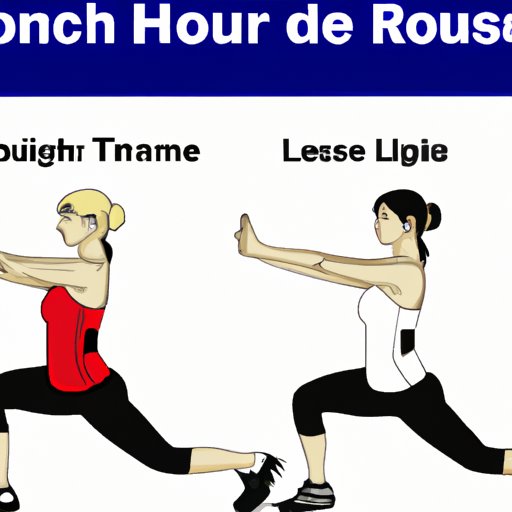Exploring the Lunge: A Comprehensive Guide to this Essential Exercise
If you’re looking for a powerful exercise that will help you build strength, improve balance, and enhance flexibility, then look no further than the lunge. This total-body move is an effective way to tone your muscles and burn calories, and it can be modified to suit any fitness level. Read on to learn more about the benefits of lunges, how to do them correctly, and how to make the most of this essential exercise.
Lunges 101: An Introduction to This Total-Body Move
A lunge is a bodyweight exercise that primarily works the legs and glutes. It involves taking a step forward with one leg and then bending both knees until they reach a 90-degree angle. Lunges can be done as part of a warmup or as part of a full workout routine.
“The lunge is an amazing exercise because it works multiple muscle groups at the same time,” says Tony Gentilcore, CSCS, a certified personal trainer. “It’s a great way to build both strength and endurance in the lower body while also engaging the core.”
Muscles Targeted by Lunges
The primary muscles worked during a lunge are the quadriceps, hamstrings, and glutes. Additionally, lunges require the use of stabilizing muscles in the hips, core, and lower back. According to a study published in the Journal of Strength and Conditioning Research, lunges can also activate the adductors, or inner thigh muscles.
Get Strong and Sculpted with Lunges
Lunges can be easily modified to increase the difficulty level and target different muscle groups. Adding weights to each hand can increase the intensity of the exercise and make it more challenging. Lunges can also be done with dumbbells, kettlebells, or a barbell.
“Weighted lunges are a great way to add resistance and work the muscles even more,” says Gentilcore. “But make sure you’re using proper form and not sacrificing technique for weight.”
In addition to weighted lunges, there are several variations of the exercise that can be used to target different muscle groups. Some variations include side lunges, reverse lunges, curtsy lunges, and jump lunges.

Developing Core Strength with Lunges
One of the main benefits of lunges is that they engage the core muscles. To maximize this benefit, it’s important to focus on engaging the core when performing the exercise.
“When doing lunges, it’s important to keep your core tight and engaged throughout the entire movement,” says Gentilcore. “This will ensure that your body is properly aligned and that you’re getting the most out of the exercise.”
There are also specific lunge variations that can be used to target the core muscles. Examples include single-leg hip thrusts, walking lunges, and lateral lunges.

How to Do a Proper Lunge for Optimal Results
To perform a proper lunge, it’s important to set up correctly and maintain good form throughout the exercise. Start by standing with your feet hip-width apart and your hands on your hips. Then take a big step forward with one foot, making sure to keep your chest up and your back straight.
Next, bend both knees until they reach a 90-degree angle. Your front knee should stay directly above your ankle, and your back knee should hover just off the ground. Push through your front heel to return to the starting position.
It’s important to keep your core engaged and your back straight throughout the entire movement. “If your back starts to round, it’s a sign that you’re not doing the exercise correctly,” says Gentilcore. “Focus on maintaining good form and you’ll get the most out of the exercise.”

The Benefits of Including Lunges in Your Workout Routine
Including lunges in your workout routine can offer a variety of benefits, including increased strength, improved balance, and enhanced flexibility. According to a study published in the Journal of Sports Science and Medicine, lunges can also help reduce the risk of injury.
“Lunges are a great way to strengthen the muscles of the lower body and improve balance,” says Gentilcore. “They can also help improve flexibility and reduce the risk of injuries.”
Making the Most of Lunges: Tips for Perfect Form
To get the most out of lunges, it’s important to warm up before exercising and maintain proper form throughout the exercise. Warming up helps to loosen the muscles and increase blood flow, which can help prevent injuries.
When doing lunges, it’s also important to keep your core tight and your back straight. Make sure to push through your front heel to return to the starting position, and focus on maintaining good form throughout the entire movement.
Finally, make sure to cool down after doing lunges. This will help your body recover and can also help reduce the risk of soreness.
Conclusion
Lunges are an excellent exercise for strengthening the lower body and improving balance and flexibility. They can be done with or without weights and can be modified to suit any fitness level. With proper form and regular practice, lunges can be a powerful tool for building strength and sculpting your muscles.
(Note: Is this article not meeting your expectations? Do you have knowledge or insights to share? Unlock new opportunities and expand your reach by joining our authors team. Click Registration to join us and share your expertise with our readers.)
